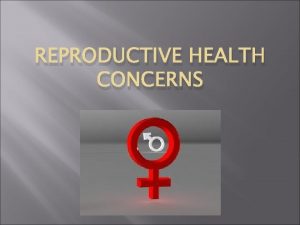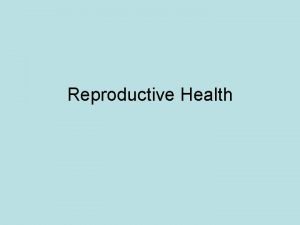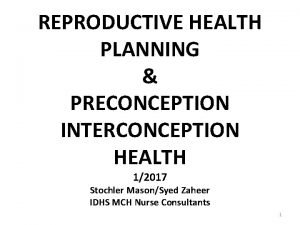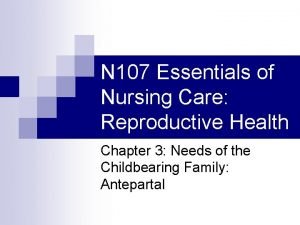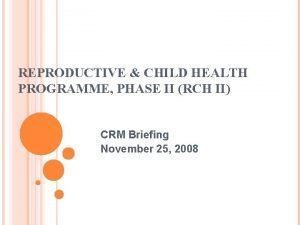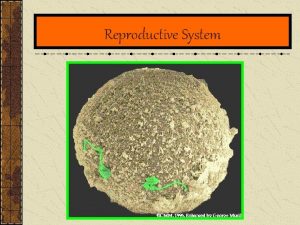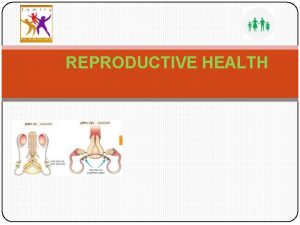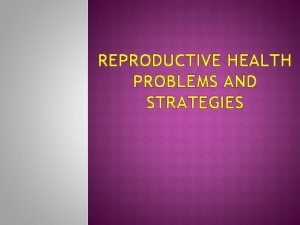Reproductive health CLASS 12 WHAT IS REPRODUCTIVE HEALTH






















- Slides: 22

Reproductive health CLASS 12

WHAT IS REPRODUCTIVE HEALTH…? � It is the state of physical, emotional, behavioral and social fitness for leading a reproductive life. � According to WHO: A total well being in all aspects of reproduction, i. e. , physical, emotional,

REPRODUCTIVE HEALTH- PROBLEMS & STRATEGIES � India was among the 1 st countries to initiate actions & plans to attain total reproductive health as social goal. � These programs are called as ‘ FAMILY PLANNING’initiated in 1951.

� Improved programs covering reproduction related areas are in operation- ‘Reproductive & Child Health Care Programs’ (RCH) � Create awareness about various reproduction aspects & provide facilities and support to build reproductively healthy society

POPULATION EXPLOSION AND BIRTH CONTROL � The increase in size and growth of human population is called population explosion. � Indian population- 350 million at independence and crossed 1 billion in May 2000 � Alarming growth rate- scarcity of basic requirements (food, shelter & clothing)

� The 1. 2. 3. 4. 5. 6. reason for high population explosion are, Decline in death rate. Longer life span. Decline in maternal mortality rate (MMR) Decline in infant mortality rate (IMR) Some religious belief against birth control. Lack of reproductive health knowledge.


CONTRACEPTION � Contraception aims to control birth, by using contraceptives � Prevention of conception or fertilization of ovum during sexual inter course is called contraception. � An ideal contraceptive should be user- friendly, easily available, effective and reversible with no or least side effects

THE DIFFERENT TYPES OF CONTRACEPTIVES ARE: 1. Natural / Traditional method 2. Barrier method 3. Intra uterine device [IUD’s] 4. Oral contraceptives 5. Injection and implants 6. Surgical method

. Natural methods: � It work on the principle of avoiding chances of ovum and sperms meeting. a) Periodic abstinence: b) Withdrawal or coitus interruptus: c) Lactational amenorrhea:

Physical contraceptive or Barrier methods: � This method prevents contact of sperm and ovum by barrier. � Available both for male and female. a) Condoms: � Barriers made of thin rubber/ latex sheath, self inserted & disposable � Covers penis in male & vagina and cervix in female. It is used so that semen do not enter the female reproductive tract. � It also prevents AIDS and STDs.

b) Diaphragm, cervical caps and vaults: � Barrier, made of rubber latex. � Inserted into the female reproductive tract to cover the cervix � Block entry of sperm through cervix, reusable � Spermicidal cream, jellies, foams along with these barriers

Intra Uterine Devices (IUDs ) � These devices are only used by female � Inserted by doctor or nurses in the uterus through vagina. � They are available as: a) Non-medicated IUDs e. g. Lippes loop: Phagocytosis of sperm b) Copper releasing IUDs (Cu. T, Cu 7, Multiload 375): � Cu ion released suppresses sperm motility and fertilizing capacity of sperm. � IUDs increases phagocytosis of

Injections or implants: � Progesterone alone or in combination with estrogen used as injections or implants under the skin of female. � Action similar to pills, effective for long periods � Progesterone or combination of progesterone and estrogen or IUDs- within 72 hours of coitus are effective as emergency contraceptives to avoid possible pregnancy due to rape or unprotected intercourse

� Emergency contraceptives: � These methods are used within 72 hours of coitus, casual in unprotected intercourse. � Administration of progesterone or progesterone-estrogen combination.


Surgical methods: � It is also called as sterilization method advised to male/ female partner to prevent any future pregnancy. � Blocks gamete transport, thus prevent conception � Sterilization in male is called-vasectomy & female- ‘tubectomy’ � Vasectomy- a small part of the vas deferens is removed or tied up through incision made on scrotum


SEXUALLY TRANSMITTED DISEASES (STDS) � Diseases or infections which are transmitted through sexual intercourse are called Sexually transmitted diseases (STDs)/ Venereal diseases (VD)/ Reproductive tract infections (RTI) � Gonorrhea, Syphilis, Genital herpes, Chlamydiasis, genital warts, Trichomoniasis, hepatitis-B and HIV

� Mode of transmission- Hepatitis- B & HIV 1. Sexual contact with infected person 2. Sharing of injection needles 3. Sharing the unsterilized surgical instruments 4. Transfusion of blood from infected person to healthy person 5. Infected mother to foetus � Except hepatitis-B, genital herpes and HIV infections, others are curable.

INFERTILITY � The couple unable to produce children in spite of unprotected sex is due to Infertility. Problems of infertility may be in male or female. � The reason of infertility may be: - physical, congenial, diseases, drugs, immunological or even psychological. � Female are blamed often in India � Specialized Health care units like Infertility clinics- diagnose, corrective treatments to have child � When treatments are not enough, couple are assisted with techniques called assisted reproductive technologies (ART)

 Inguinal hernia are a female reproductive health issue
Inguinal hernia are a female reproductive health issue Mention any two different goals of rch programme
Mention any two different goals of rch programme Meaning of reproductive health
Meaning of reproductive health Reproductive health definition
Reproductive health definition Height of fundus during pregnancy
Height of fundus during pregnancy Rch 2
Rch 2 Today there is class
Today there is class Package mypackage class first class body
Package mypackage class first class body Abstract class vs concrete class
Abstract class vs concrete class Measures of central tendency for grouped data
Measures of central tendency for grouped data Class i vs class ii mhc
Class i vs class ii mhc Abstract concrete class relationship
Abstract concrete class relationship Class interval example
Class interval example Stimulus
Stimulus Discriminative stimulus psychology definition
Discriminative stimulus psychology definition Therapeutic class and pharmacologic class
Therapeutic class and pharmacologic class Class maths student student1 class student string name
Class maths student student1 class student string name What is the class width for the given class (28-33)
What is the class width for the given class (28-33) In greenfoot, you can cast an actor class to a world class?
In greenfoot, you can cast an actor class to a world class? Static vs dynamic class loading in java
Static vs dynamic class loading in java Hbm class 2
Hbm class 2 Static uml diagrams
Static uml diagrams Class 2 class 3
Class 2 class 3
